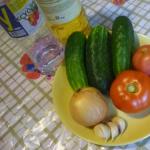Many of us associate childhood memories with getting our hands and faces dirty with the help of an unusual berry - the mulberry. Who among us does not remember the blue-violet consequences of this small piece of summer, which are difficult to wash off, but which are no less difficult to refuse, because the sweet taste of mulberries is so unusual and attractive.
It is not for nothing that in ancient times scientists and philosophers noted the beneficial and nutritional properties of the mulberry tree, called simply Tutom in Central Asia. It’s a pity, of course, that you can only enjoy this berry for a limited amount of time; it ripens quickly and crumbles.
You can preserve it for a longer period by preparing sweet and aromatic mulberry jam or syrup. You will not only get a filling for a lot of delicious dishes with preserved beneficial properties of berries, but also a prophylactic for various cardiovascular and gastrointestinal diseases and hypochromic anemia. There are 12 types of mulberries in total; they are similar in structure to raspberries and are white, pink, red, purple or almost black. Mulberries contain large amounts of resveratrol, a powerful plant antioxidant.
In order to collect mulberry fruits, you can use the proven old-fashioned method - spread a large oilcloth under the tree and shake the tree. The ripest and cleanest berries will fall on the oilcloth.
Mulberry jam - preparing dishes
Cook mulberry jam in ordinary containers designed for cooking any jam. This can be an enamel pan or basin, as well as other utensils made of copper or stainless steel. To pack the jam, small sterilized jars must be dried and the lids must be boiled.
Mulberry jam - fruit preparation
Only a few types of berries are considered most suitable for cooking. First of all, this is a sweet and sour cherry-red (Hartroot variety), it ripens in August, it is difficult to separate from the stalk, so large-fruited berries will have to be cut with scissors. White mulberry, which also has tender and juicy pulp and medium-sized fruits, is also perfect for jam. Other varieties: semi-wild pink, white and red mulberries are not as tasty, but can also be used for jam.
We sort the berries and cut off the stalk.
Mulberry jam - recipe 1
Rinse the berries in a sieve and let them drain well. Then place in an enamel bowl or pan, while sprinkling with sugar in layers. Leave for 4-8 hours, during which time berry juice should appear. Keep over low heat until the sugar is completely dissolved, stirring gently, removing foam during the entire cooking process, then remove from the stove for 30 minutes. Add citric acid and repeat again over higher heat. For this recipe you will need 1 kg of peeled mulberries, one and a half kilograms of sugar and a little citric acid (2-3 grams).
Mulberry jam - recipe 2
White mulberries are sweeter, so the sugar consumption for this variety is slightly less. According to our recipe, you first need to prepare the syrup and pour it over the berries, let it sit for 3-4 hours so that the berries remain intact and do not spread, then again, using a sieve, separate the berries and boil the syrup to a boil. Place the berries in the syrup again, add citric acid and cook until tender. Ingredients: berries 1 kg, sugar (for white varieties 1.2 kg, for black varieties 1.5 kg), citric acid.
Mulberry jam - recipe 3 Jelly
Prepare juice from the berries; to do this, heat the crushed, washed berries over low heat; as soon as the juice begins to release, simmer, covered, for 10 minutes. Cool a little so that you can squeeze out the juice, then add gelatin, boil over high heat and cook for a minute. Quickly remove the foam from the hot jelly and roll the jam into prepared jars, then keep in boiling water for another 5-6 minutes.
Mulberries in sugar syrup recipe 4
This type of canned food will work well from any variety of mulberry. The washed berries are laid out on oilcloth in one layer. After drying the entire surface, pass them through a meat grinder and pour in pre-cooked sugar syrup (for 1 kg of mulberries, 1.2 kg of sugar and 300 grams of water). The hot mixture is packaged in jars to the top and covered with parchment paper soaked in alcohol. The diameter of the circles should match the outer diameter of the jars. Cover tightly with lids and leave to cool.
- Mulberry jam can be pasteurized rather than boiled. Filled jars are kept at a temperature of 90 - 95 degrees, half liter jars for 9-10 minutes, and liter jars for 15 minutes.
- To keep the berries intact, do not stir the jam in the container too vigorously. To increase shelf life, wrap hot jars in a warm towel and leave them to cool in a warm place.
- The jam can turn out too sweet and cloying, especially in white varieties, so you can significantly reduce the sugar levels. Practice suggests that in some cases it is enough to add 700 grams per 1 kilogram.
Mulberry jam turns out to be very healthy, tasty, sweet and aromatic. For many people, its unusual taste reminds them of childhood. It’s very easy to cook the delicacy yourself. There are recipes for cooking from both white and black mulberries, which every housewife should familiarize themselves with.
How to make mulberry jam correctly
Mulberry berries have a huge number of beneficial properties. Once picked from the tree, it is not stored for long, but lends itself well to heat treatment. In homemade mulberry jam, all the healing components of the fresh berry remain. The treat contains:
- glucose;
- fructose;
- essential oils;
- vitamins C, E, PP, K, group B;
- carotene;
- calcium;
- zinc;
- magnesium;
- sodium;
- potassium;
- iron.
Due to the high concentration of nutrients, mulberry jam helps fight many diseases. It is recommended to use:
- with weak immunity;
- frequent colds;
- problems with the nervous system;
- infections;
- hypertension;
- stomach diseases;
- diabetes mellitus;
- stress;
- depression;
- insomnia;
- heart failure;
- metabolic disorders;
- renal dysfunction;
- fever;
- cough;
- bronchial asthma.
Before making jam, it is necessary to select and prepare the fruits picked from the tree. Black or white mulberries are suitable, but red and pink ones will not be sweet enough. Take ripe berries; overripe ones will not suit you. They must be intact. If you find rotten or moldy ones, throw them away. Rinse the berries thoroughly and drain them in a colander. Cut off the stalks with scissors. Be sure to sterilize the seaming jars.

White mulberry jam
For the recipe you need the following products:
- mulberry fruits – 2 kg;
- sugar – 2 kg;
- water – 0.5 l;
- vanilla sugar – 10 g.
Mulberry jam is prepared as follows:
- Sort the berries, cut off the stalks. Rinse them under running water and dry in a colander.
- Heat up the water. Pour sugar into it and wait until it boils. When the sugar has dissolved, remove the pan with the resulting syrup from the heat.
- Place the mulberries into the warm liquid and stir gently. Let the workpiece cool completely.
- Place the syrup on the stove, wait until it boils and cook for three minutes, stirring occasionally. Turn off the heat and let cool completely.
- Boil twice more for five minutes after boiling. Add vanillin to the hot stock after the last cooking, pour the jam into jars and roll up the lids. Store where it is dark and cool.

Black mulberry jam
Components:
- mulberry – 2 kg;
- sugar – 2.5 kg;
- citric acid – 4 grams (half a teaspoon).
Cooking process:
- Rinse the berries under running water, placing them in a colander. Leave to dry.
- Sort through the mulberries, cut off the stems.
- Mix berries and sugar. Do this very carefully so as not to wrinkle them. Shake the container until all the mulberries are coated with sugar.
- Leave the food for three to four hours for the juice to flow. If there is too little liquid, add a glass of warm water.
- Place the dish with the preparation on the stove. Turn the heat to medium.
- Ten minutes after boiling, remove the pan from the stove and remove the foam.
- After half an hour, return to the stove. Cook the syrup for five minutes from the start of boiling three more times. Cool for half an hour each time. During the last cooking, add citric acid to the syrup.
- Pour warm jam into jars and roll up. Store upside down and under a blanket until completely cool. Then you can put it somewhere cool.
Video: mulberry jam
The white mulberries have already ripened. Many people like to make white wine from it, which is not only tasty, but also very healthy. However, few people know that white mulberry jam is an excellent anti-inflammatory agent, and therefore can be eaten when you have a cold. After all, mulberry jam has the same effect as raspberry jam. In addition, white mulberry juice, even when boiled, is rich in potassium and vitamin C, so it perfectly strengthens your immunity. It has also been noted that white mulberry berries perfectly calm the nervous system and promote normal sleep.
To start making this jam, you should collect ripe berries that are not crushed or spoiled by wasps from the trees. If it is difficult for you to collect from a tree, then you can spread a sheet or other fabric under it, then shake the twigs and sort out the berries from the garbage. The collected white mulberry variety is lightly washed under running water. It is not necessary to tear off the tails of the berries - this will take too much time. In addition, vitamins are also preserved in ponytails. Then you should dry the mulberry by simply laying it on a towel and letting it drain a little. 
The lemon should be cut into pieces along with its peel. To make it more convenient, you can cut it first into rings, then either into triangles or cubes. Then the lemon should be crushed in a blender or meat grinder. But you should grind the lemon very quickly in a meat grinder - because the metal parts will oxidize very quickly. 
Place mulberries and lemon in a saucepan and cover with sugar. All this should take about 3-4 hours. You should boil for several minutes - 2-3 - but the jam should boil over medium heat. After the contents of the pan have boiled for a few minutes, you need to turn everything off and let it cool. Then put it back on low heat and boil for 2-3 minutes. And the last time you can leave it to simmer over low heat for about 30 minutes. 
After the jam has cooled, you can put it in jars and close the lid. This container can be stored in the refrigerator. But if you want to preserve jam for the winter, then it is best to put it in jars while still hot. Jars and lids should be sterilized, so you need to wear oven gloves to avoid burning your hands. 
Some people like to make jam from this jam. Then add gelatin to the mixture after cooking. If you do not want to use gelatin, then you need to boil the future jam for several minutes over low heat, 5-6 times. Remember to always stir the brew thoroughly, otherwise the smell from the burnt on the bottom will spoil the whole taste. 
Of the negative effects of mulberry jam, only those moments are noted when you eat it in fermented form. Then diarrhea and mild poisoning may occur. Therefore, pay attention to the freshness of such jam and store it in a dark, cold place (refrigerator or cellar).




Everyone knows the incredibly tender and sweet mulberries. White, red, black, hybrids of different varieties - there is a lot of it growing in our latitudes. Outwardly it is slightly similar to, but the taste is completely different. Yes, and it grows on trees. And its juice is difficult to wash off your hands. It’s rare that when you were a child you didn’t feast on these berries straight from the tree!
Origin
It came to us in the late Middle Ages from Central Asia, and there from Africa. It also grows in North America, and in China it has been known since the third millennium BC. Then it was grown as a source of vitamins, and in addition, the berries could be used to make a very durable paint for fabrics. They also learned how to make silk there, the secret of production was carefully protected, the export of silkworms was prohibited on pain of death, and only an accident revealed it.
Black, red and white mulberries came to Europe from different places, but they have taken root here well. Botanists have even developed different varieties of mulberries of each color and their hybrids.
The mulberry is also called the mulberry tree. Silkworm larvae feed on its leaves. They are then used to extract thread for the production of silk fabrics - hence the name of the insect. Leaves are specially collected on farms for larvae. Each of them needs more than 10 kg per day.
Each finished silkworm cocoon contains about 1 km of thread.
Mulberries are very soft and tender; picking them is quite labor-intensive. It is much easier to spread an oilcloth under the tree and hang them on it. Then the berries fall the ripest and most intact.
Beneficial features
Mulberry is a healthy berry that must be included in the human diet. What's unusual about it?
- It is an excellent antioxidant - it intensively removes toxins, regulates hemoglobin, and improves immunity. It contains many vitamins, and in terms of the amount of vitamin C it is confidently ahead of citrus fruits. In addition, it contains a complex of vitamins B, which are essential during pregnancy, such as E and K.
- It contains a large amount of potassium. This microelement is urgently needed for people with cardiac problems. In case of shortness of breath, heart disease, threat or after a heart attack, it is recommended to consume foods with large amounts of potassium and mulberry is irreplaceable in this regard.
- It improves kidney function, helps remove swelling of various origins, and regulates blood pressure.
- It has diuretic properties and is excellent at driving bile.
- Dried mulberries are necessary for diabetics - they significantly lower blood sugar levels.
- This is an anti-inflammatory plant.
- Fresh white mulberry juice is useful for colds, has expectorant properties, and helps lower fever.
- Unripe black mulberries relieve heartburn, and overripe ones are an excellent natural laxative.
- Mulberry has a good effect on liver function and helps with various hepatitis.
- This is a good wound healing agent - its juice promotes the rapid healing of fresh, shallow cuts.
- Mulberry is a lactogenic plant and is highly recommended for nursing mothers. And in any form - raw, boiled, juice, compote.
- It is quite hypoallergenic and can be given to babies as early as six months.
- Mulberries are quite low in calories - 100 grams of fresh berries contain (depending on the variety) from 40 to 50 kilocalories.
In folk medicine, its juice is also used as a remedy for lichen - damaged areas of the skin are generously lubricated with it.
It is also a good mild sleeping pill, relieves stress, and is indicated for students during sessions and for athletes during heavy physical activity. And most importantly, it’s simply delicious! In a word - eat mulberries and be healthy.
But even such a wonderful berry may have its contraindications. Even that can cause harm.
Harm
- If you eat low-quality berries - sour, unripe or in large quantities - they can lead to digestive disorders.
- Its juice does not combine well with the juice of other fruits - such a cocktail often causes fermentation in the stomach, so it is better to use it in its pure form. It is only “friendly” with citrus juices – no problems arise in combination with them.
- It is better to consume it on an empty stomach, at least an hour before meals, so that mulberries do not mix with other foods and there are no problems later.
- And, of course, if you have an individual intolerance to mulberry. To check if you are allergic to it, lubricate the skin on your wrist or elbow - if redness and inflammation appear within a few hours, mulberry is contraindicated for you.
- Mulberries have the ability to strongly absorb harmful emissions into the air. Therefore, you should not purchase it from unverified sources. The berries could have grown on a tree near the road or in other polluted places and absorbed heavy metal salts and car exhaust. Or even grow up near nuclear power plants. Buy them only from reliable suppliers, do not go for cheapness, so that the healthy berry does not become poisonous and cause harm instead of the expected benefit.
The peculiarity of this berry is that it is very poorly kept fresh and spoils very quickly. It must be processed the same day it is collected, because even unripe and hard ones begin to rot. And one of the processing methods is jam.
There are many ways to make mulberry jam for the winter, and it will always be tasty and healthy. Mulberry jam provides almost all of the beneficial properties of fresh berries. Vitamin C, which disappears during cooking, can easily be replenished by adding fresh lime or lime.

If your child gets very dirty with black mulberry, wipe the stains with white mulberry juice - they will wash off easily. This applies to both skin and clothing.
Mulberry jam
Let us warn you right away - mulberry is a very juicy berry, and when it is covered with sugar, a lot of juice is formed. It is recommended to drain half of this juice, otherwise the jam will turn out to be too liquid.
The jam itself is not like others. It has a very special texture, a viscous syrup that gently envelops the berries. And this syrup itself is of an extraordinary color with an amazing deep radiance.
Before cooking, the berries must be carefully prepared - select spoiled ones and cut off the stem from the rest. The berries themselves may be slightly unripe - this way they will better retain their shape when cooked.
To make mulberry jam at home, you can take any variety, and even different colors at the same time. All berries take the same amount of time to cook, so there won’t be any difficulties.
Will need
- mulberry – 2 kg
- sugar - 2 kg
- vanilla - 1 sachet
- lemon zest - teaspoon
You don’t need to add vanilla and zest - they are only needed for additional aroma.
If you are preparing white mulberries, use a little less sugar, as they are sweeter than black ones. Proportion: 3 cups of sugar per 1 kg of berries.
How to cook

You can make jelly from the remaining syrup. Add another glass of sugar, simmer over low heat for about an hour - so that the syrup almost does not boil. It will then boil down and become quite thick.
There is also a recipe for mulberry jam - it is more complex, but the result is more interesting.
The fact is that the mulberry itself is very sweet, and with the addition of sugar it becomes even sweeter. Many people may not like this, so it’s better to “disguise” the sweet taste a little and set it off with something else. And in this sense, the sour taste of lemon or lime is perfect. The taste of the jam will become more intense, and the jam itself will become more beautiful. So try making mulberry and lemon jam.
So, you will need
- Mulberry – 1 kg
- Sugar – 1 kg
- Lemon or lime - 1-2 pcs.
Cooking procedure
- Wash and dry the berries, remove the stems.
- Lightly chop the berries with a blender.
- Add sugar and place over medium heat for 10 minutes.
- Wash and scald the lemon or lime and remove the skin. Cut it into small cubes, about 1 cm, and add to the berries. These pieces will make original candied fruits. If you don’t like these, you can put this skin in without cutting it, and take it out a few minutes later.
- Boil for another five minutes, squeeze in lemon juice, bring to a boil and turn off. Lemon can also be cut into slices and put in jam. But then the lemon itself will “clog” the taste of the mulberry, so be careful.
- When it cools down, roll it into sterilized jars and preserve in the usual way. This jam will turn out very tasty, with a pleasant lemon aroma and slight sourness. It will have almost the same consistency as jam, so it can be used as a filling for baked goods.
If you reduce the amount of sugar and add some hot spices, you will get an original seasoning for meat dishes.
This is such an unusual, simple-looking berry, familiar from childhood. So collect it, make some jam, and let it bring you pleasure all year long!
Making homemade mulberry wine
If you find an error, please highlight a piece of text and click Ctrl+Enter.
Ingredients:
- per 1 kg. mulberry (mulberry)
- 0.5 kg. Sahara
To preserve mulberry jam, we will also need 0.5-1 liter glass jars, lacquered metal lids, and a seaming key.
Preparation:
- We collect mulberries (mulberries) or buy them at the market.

- Mulberry is a delicate berry, so it is better to start processing it right away. Place the berries together with the stalks (tails) in a colander, rinse, and let the water drain.

- We transfer the mulberries into a saucepan in which we will cook the jam, add sugar, and stir. The mulberry releases juice immediately.
- Sterilize jars thoroughly washed with soda or soap over steam (up to 10 minutes), and lids (also thoroughly washed) - 5-7 minutes. in boiling water. You can also sterilize jars in the oven (see recipe).
- Place the berries and sugar on medium heat; when the mulberries boil, reduce the heat and cook for 15 minutes. The jam is similar in thickness to. We check the readiness of the jam by dropping a little onto a saucer - a drop should not spread.
- Immediately fill prepared (sterilized) jars with the prepared jam (1 or 2 jars at a time), cover with lids and roll up.

- Immediately after rolling, place the jars of mulberry jam upside down on the floor covered with newspapers and check the tightness to see if any of the jars are leaking. And leave to cool, covered with old blankets.
- When the jars of jam have cooled completely, you can turn them over and wipe them with a damp sponge or cloth. When the jars are dry, for convenience, you can glue labels made of paper or masking tape to them, where you can indicate the date of sealing and the name of the jam. Or you can label the lids of the jars with a marker.
- We put the jam prepared for the winter in the pantry or cellar.
- And when the time comes, open a jar of aromatic mulberry jam and serve with tea along with




















